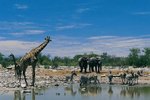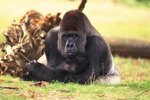
The two species of orangutans -- Bornean (Pongo pygmaeus) and Sumatran (Pongo abelii) orangutans -- are the only great apes living in Southeast Asia. Location isn't the only thing that sets them apart from gorillas, bonobos and chimpanzees, however. Orangutans also are the only great apes that spend the vast majority of their time in trees. These primates have a number of physical adaptations that enable their arboreal lifestyle.
Strong-arm Tactics
Although the largest male orangutans reach heights of about 5 feet, their arms are at least 7 feet long. These disproportionately long arms, combined with comparatively short legs, help orangutans support their body weight as they hang from tree limbs. Since these great apes may weigh as much as 200 pounds, strong arms are necessary to keep them from falling out of the trees. More highly flexible hips also suit them well to their arboreal lifestyle, given that they use both their arms and legs to move from tree to tree.
Getting a Grip
Orangutans not only need strong arms, but strong hands and feet as well. These cautious climbers use all four of their limbs to grasp trees, testing each branch to ensure it will hold their weight before moving forward hand over hand. Both their thumbs and their big toes are opposable, so their feet grip much the same way their hands do. Orangutans have flat nails instead of claws, and sensitive tactile pads on their fingers. They control the movement of each individual finger, and have adapted unique grips depending on whether a task requires precision or power.
Hidden in Broad Daylight
Orangutans' reddish-orange fur is no accident, but an adaptation to camouflage them as they move about in the rain forest canopy. Despite their large size, these great apes are practically invisible as they move from tree to tree. As the sun shines down on the jungle, the dense vegetation absorbs red and orange light. By the time light filters down to the forest floor, red and orange light are almost completely absent. By complementing this portion of the light spectrum, orangutans also disappear to eyes looking up.
Long Call of the Wild
Unlike the other great apes, orangutans live a largely solitary existence. Primatologists attribute this in part to the fact that rain forest trees would be unable to support large numbers of these large creatures at once. Mature males have a unique "long call" produced by puffing up the large pouches in their cheeks and throat. This call can be heard for several miles, and serves as a warning to other males who may be in the area as well as notifying potentially receptive females of their location.
References
- Woodland Park Zoo: Orangutan
- SeaWorld: Orangutans -- Adaptations for a Forest Environment
- University of Wisconsin LaCrosse Science and Health: The Orangutan -- Adaptation
- University of Wisconsin National Primate Research Center Primate Factsheets: Orangutan (Pongo) Taxonomy, Morphology and Ecology
- University of Wisconsin National Primate Research Center Primate Factsheets: Orangutan (Pongo) Behavior
Photo Credits
-
Anup Shah/Digital Vision/Getty Images
Writer Bio
Jennifer Mueller began writing and editing professionally in 1995, when she became sports editor of her university's newspaper while also writing a bi-monthly general interest column for an independent tourist publication. Mueller holds a Bachelor of Arts in political science from the University of North Carolina at Asheville and a Juris Doctor from Indiana University Maurer School of Law.




